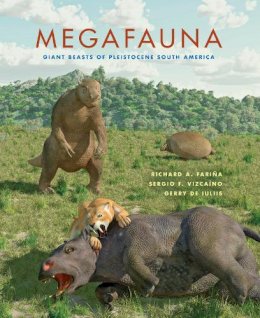Richard A.Fariña is Professor of Paleontology at the Facultad de Ciencias, Universidad de la República, Montevideo, Uruguay. He has also published science books for a general readership and collaborated in TV documentaries on the subjects of his expertise. Sergio F. Vizcaíno is Professor of Vertebrate Zoology at the Universidad Nacional de La Plata and researcher of the Consejo Nacional de Investigaciones Científicas y Técnicas working at the Museo de La Plata, Argentina. His research focuses on the paleobiology of South American fossil vertebrates, mostly mammals. He has participated in numerous field work seasons in Argentina and Antarctica. He was the President of the Asociación Paleontologica Argentina. Gerry De Iuliis is affiliated with the Department of Ecology and Evolutionary Biology at the University of Toronto.
"Overall, [this] is an enjoyable read that provides a substantial amount of detail on the biology, ecology, and distribution of these fantastic animals. . . . Highly recommended."—Choice "Collectively, this book brings attention to the discovery and natural history of ancient beasts in South America while providing a broader temporal and geographic background that allows readers to understand their evolution and potential immigration to South America."—Quarterly Review of Biology "The conversational tone in this volume makes it a pleasure to read. I recommend this book for anyone interested in paleontology, students new to the subject, graduate students, and researchers who want to become well grounded in late Neogene paleontology of both Americas."—Journal of Vertebrate Paleontology "This is an excellent volume. Its structure is complex, serving well the multitude of topics the authors managed to treat in a reader-friendly, yet rigorous manner that will satisfy both specialists and general paleontologists and the educated reader. . . This book is likely to facilitate progress in the understanding of fossil mammals from the Americas."—Priscum "These bizarre beasts are wonderful exemplars of parallel evolution, controversial in their implications for competition/extinction . . . and just plain intriguing!"—Donald Prothero, author of After the Dinosaurs: The Age of Mammals "The history of the South American megafauna is a fascinating topic. For much of the Cenozoic Era South America was an island continent in which the carnivores were all marsupials and the herbivores were primitive ungulates that evolved into forms functionally similar to unrelated animals found elsewhere in the world. [They] were a unique blend of indigenous and immigrant animals that had apparently reached equilibrium in the wake of the Great American Interchange. When and why many of them subsequently went extinct has yet to be fully resolved."—John Harris, Chief Curator of the George Page Natural History Museum

